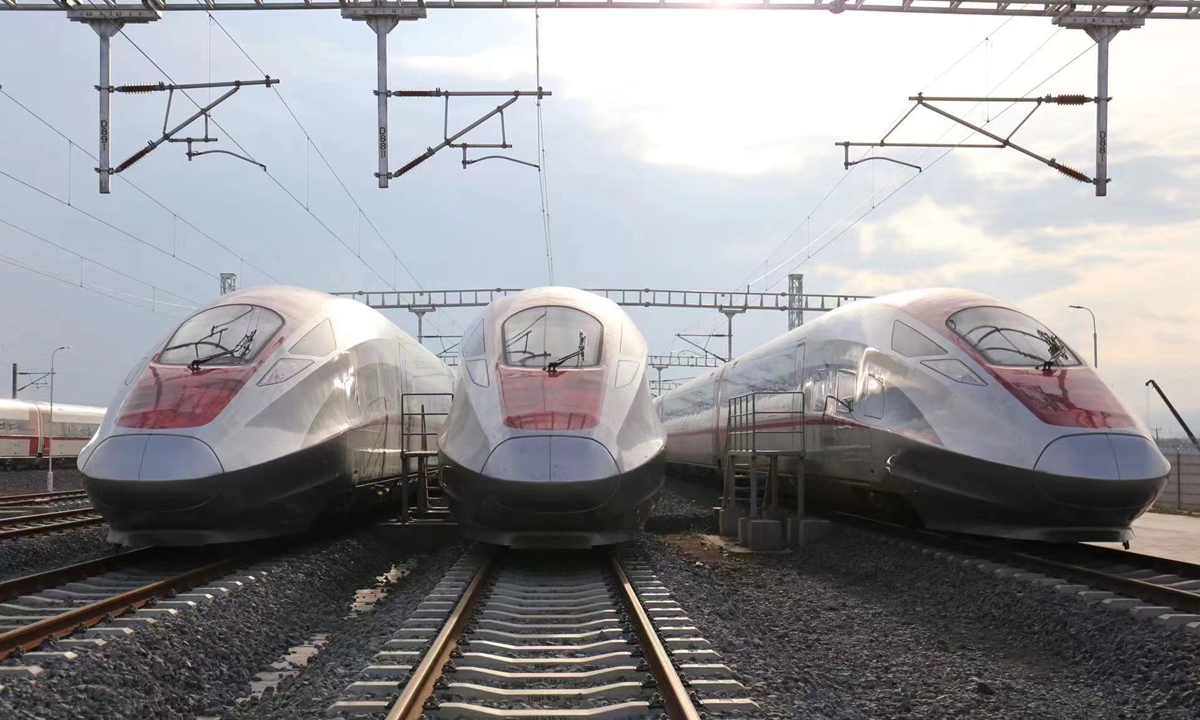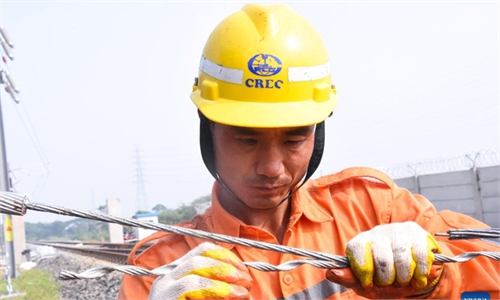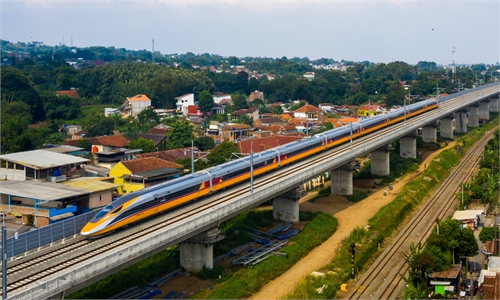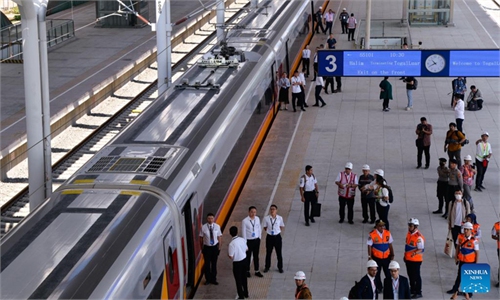Jakarta-Bandung HSR enters intensive testing phase, launch imminent
Official launch date 'special moment' for Chinese engineers, Indonesian commuters

A view of Electric Multiple Units trains at Tegalluar Station in Bandung Photo: Zhao Juecheng/GT
The Jakarta-Bandung High-Speed Railway (HSR) is now undergoing intensive joint commissioning and testing, involving the operation of the electric multiple unit (EMU) trains and the comprehensive inspection train (CIT).
Those tests will continue until the line starts trial operations and officially opens, the Global Times learned from PT Kereta Cepat Indonesia China (KCIC), a consortium of Indonesian and Chinese firms responsible for developing and operating the HSR.
It is expected that the link, a landmark project under the China-proposed Belt and Road Initiative (BRI), will enter commercial operation in August, which is likely to coincide with Indonesia's 78th Independence Day on August 17.
As the official day of operation draws near, Chinese engineers and project participants told the Global Times that their feelings could be compared to "sitting in for the national college entrance exam." They're excited to see eight years of hard work pay off, and they feel a sense of responsibility to ensure the line operates smoothly.
"It is expected that the HSR will run for free at first. It will provide a new experience for Indonesia and generate data that helps the company to verify the operation plan, such as how many trains should run daily," Zhang Chao, the board director of KCIC, told the Global Times. The plan will be subject to dynamic changes as the traffic flow rises.
The HSR connects Indonesia's capital Jakarta and its fourth-largest city Bandung, capital of West Java Province, one of the world's most heavily populated regions. It is the first HSR in Southeast Asia with a design speed of 350 kilometers per hour.
The line, spanning 142.3 kilometers and covering a massive population of 40 million, will cut the journey between Jakarta and Bandung from more than three hours to just 40 minutes.
At the initial stage, the designed capacity will be about 30,000 passengers a day, and it will double in five years, Xin Xuezhong, chief of Jakarta-Bandung HSR's consortium of contractors, told the Global Times.
Zhang said that the fares will be set in "a reasonable range," taking account of the cost, what people can afford and the return on investment. "The pricing mechanism is based on a feasibility study, with advice from major consulting firms such as KPMG and PWC."
'Special moment'
In June, the CIT of the HSR reached 350 km/hour for the first time, as part of the incremental speed tests that started in May. These tests will provide strong support for subsequent trials and actual operations. Other tests involve the tracks and overhead lines, the Global Times learned.
It's first time that a Chinese high-speed railway has been built abroad with systemic and whole-of-supply chains. Zhang, a founding board member of KCIC when the joint venture was set up in 2015, described the HSR as "a vivid display of Chinese standards" in terms of stability, efficiency and economics.
Looking outside Zhang's office in the KCIC building in Jakarta, the HSR's initial station - Halim Station - is within sight, with dozens of workers on the lattice roof to finish the project.
Zhang saw how Halim Station was built from scratch. As one of the first Chinese personnel involved in the project, he could pinpoint every important stage: the opening ceremony, the awards of various certificates, the signing of the financing agreement, the completion of the first roadbed, the completion of all tunnels and rail tracks, and the start of the joint commissioning and tests.
"Every juncture matters and nothing was easy during the past eight years. It's like cleaning different rooms, you finish one but there are more waiting," Zhang recalled.
"We eventually moved to the stage of the national college entrance exam. We're excited. But we're also clear that work isn't finished, just as after graduating college, people need to enter the job market," Zhang noted.
One of the most challenging tasks was land acquisition, which was completed in 2021 after a revision of Indonesian legislation that altered the project's land use purpose from commercial to a national strategic project, according to Zhang.
Indonesia's unique geography posed some difficulties, but the Chinese and Indonesian engineers managed to overcome them and create a project that lives up to the highest Chinese railway standards, Xin said.
Overcome difficulties
For example, Indonesia sees dense rain every year, and earthquakes between Jakarta and Bandung could reach the magnitude of eight, so the project has high requirements on waterproofing, drainage and quake resistance.
Putting the project into operation will be a special moment for the Chinese engineers, and it will also be beneficial for people in Indonesia, where the original sketch of the BRI was mapped out a decade ago.
On social media platforms like Facebook and YouTube, a rail section near the terminal Tegalluar station has become a "hotspot" for hundreds of Indonesian online celebrities and members of the public, who share videos about the project's development and testing.
These high expectations, a shift from opposition and doubts at the early stage, show how the landmark BRI project has boosted connectivity in infrastructure and people-to-people links between China and Indonesia.
"In 2015 and 2016, we faced numerous hardships. Protestors even demonstrated in front of our office building. Some locals remained skeptical on whether Chinese bidders could perform better than Japanese bidders in railway technology," Zhang recalled.
But as the project progressed and delivered benefits to the society, local support grew. Zhang said that in about 2019, the company received a lot of inquiries about when the HSR would open.
Another watershed was the launch of the trial operation on the sidelines of the G20 Leaders' Summit last year, which further elated Indonesians.
According to Xin, the project has created 51,000 jobs for Indonesians during the construction stage, and the Chinese side is also helping to train local HSR drivers.
More than 60 percent of the procurement was done locally, which helped to develop the local infrastructure industry such as the industrial chains for concrete and bridge construction, Chinese engineers said.
Observers said that the HSR is a vivid example of building a community with a shared future for mankind. As the Chinese and Indonesian sides join hands to withstand challenges, the cooperation also embodies "extensive consultation, joint contribution and shared benefits," a principle underpinning the development of the BRI over the past 10 years.




